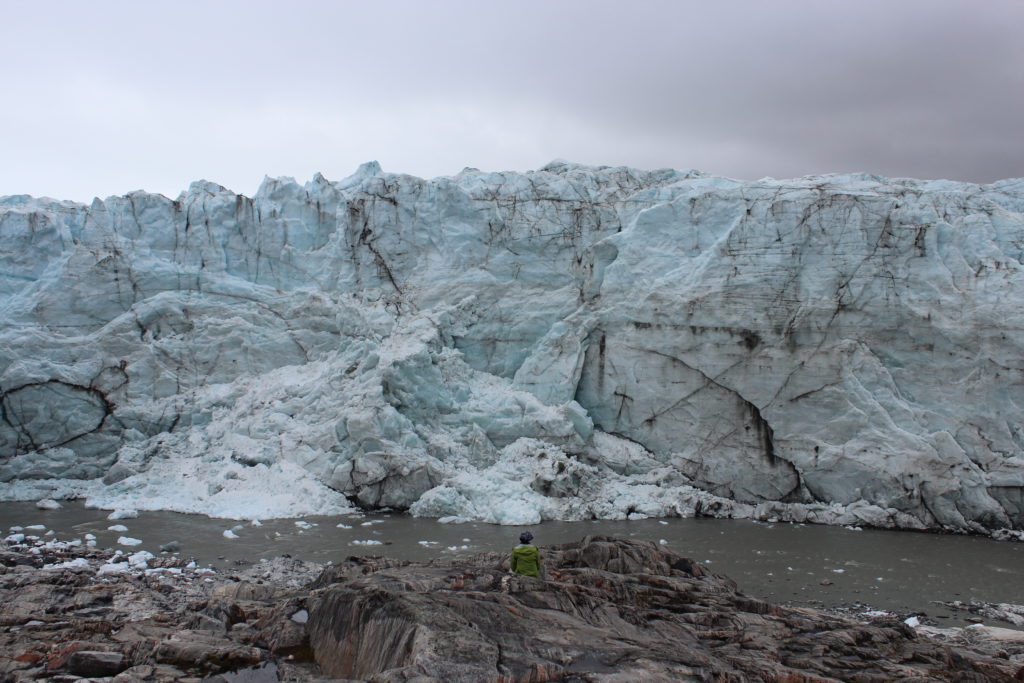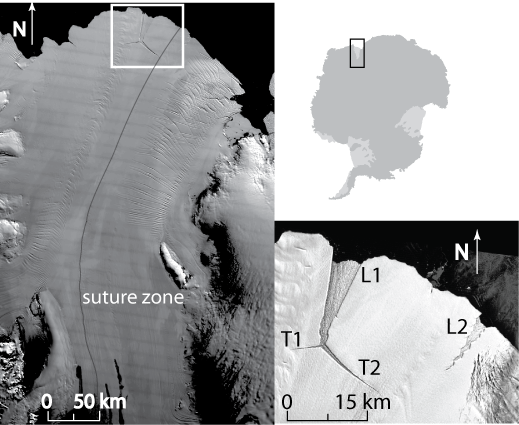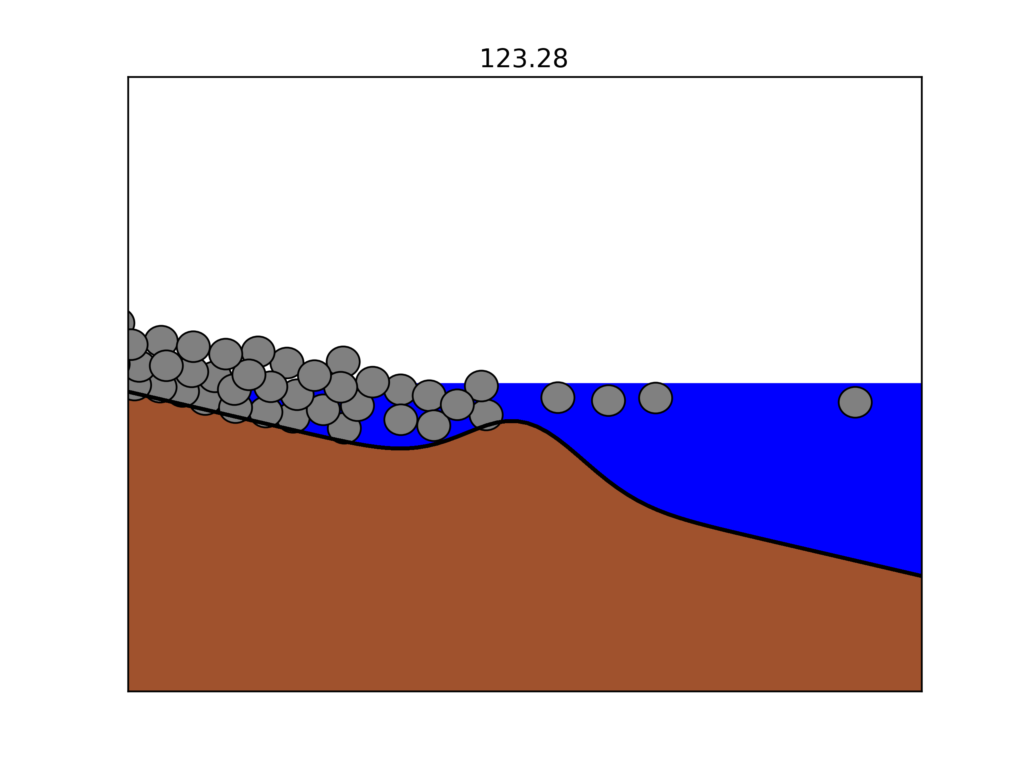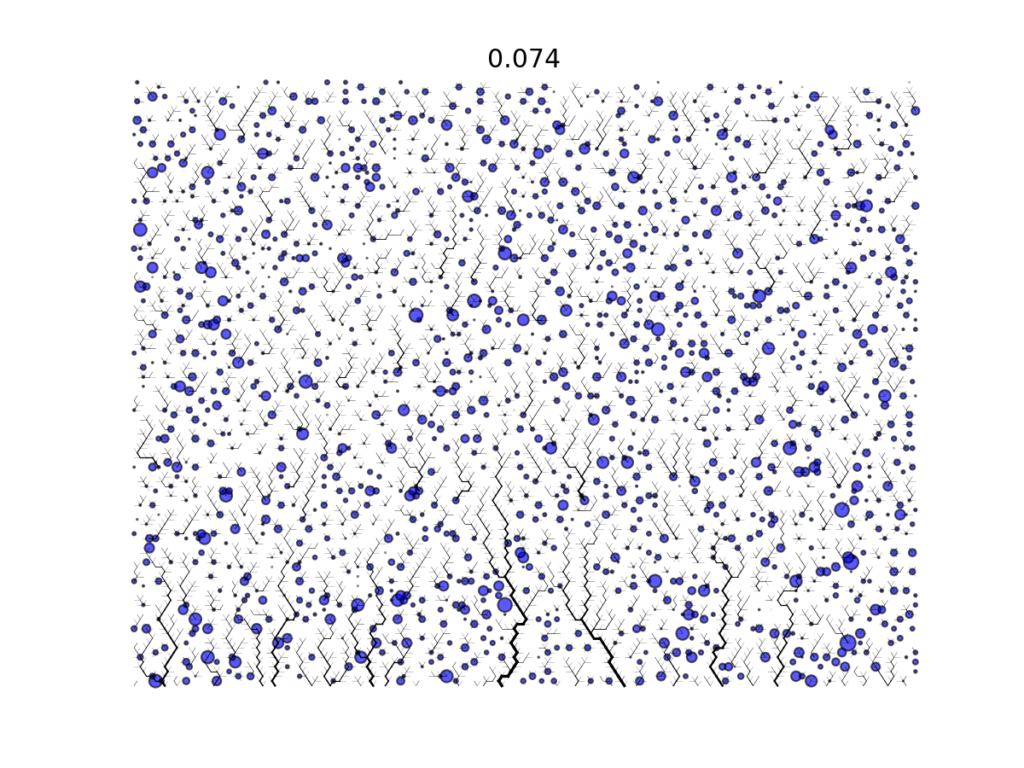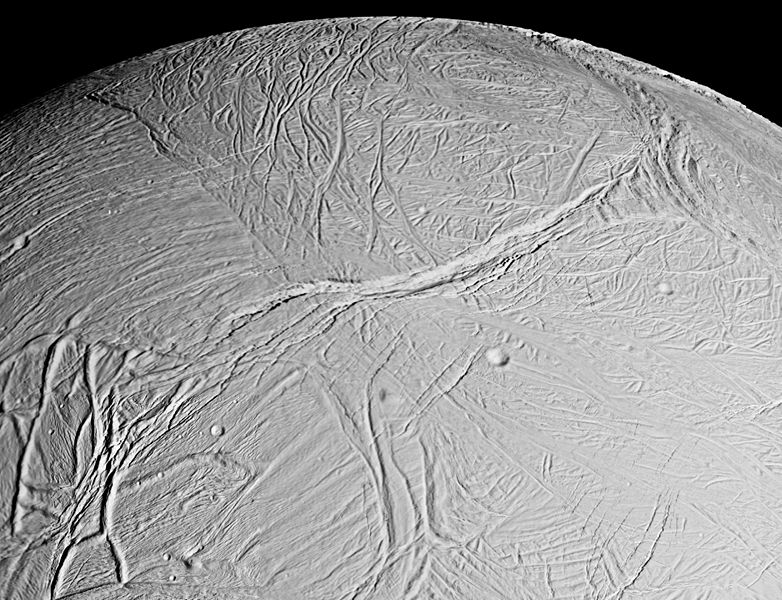A word about my research philosophy
My research involves a mixture of computational work and analytic exercises and I expect students who work with me to develop some affinity and maybe eventually a little affection for programming. However, good science is essentially empirical and models are only as good as the observations we have to test them. Going out and collecting data is also an important component of the research I do. Since this often involves traveling to glaciers, it helps to have a sense of adventure and a healthy dose of scientific curiosity. The mathematical and computational tools needed to do research can mostly be picked up as on-the-job training. Curiosity and a sense of adventure cannot.
Research Themes
Marine ice sheet and ice cliff instability
Glaciers end in near vertical cliffs submerged in the ocean. These cliffs advance (through ice flow) but can also break in a process called iceberg calving. About a decade ago, we proposed that, contrary to most existing theories of how icebergs detach, when glaciers retreat into an over-deepening basin—or ice shelf collapse exposes tall ice cliff ice cliffs that can become structurally unstable and crumble under their own weight. This process, called the marine ice cliff instability, can be activated in portions of the Antarctic and Greenland ice sheets grounded deep beneath sea level potentially leading to runaway cliff failure and ice sheet disintegration. Marine Ice Cliff instability was only recently proposed and has yet to be observed. We are using a suite of models and observations to try to understand when (or if) cliffs become unstable. This includes simulating past ice sheet disintegration, like Heinrich Events, along with modern glacier retreats.
Ice shelf rifting
Icebergs episodically detach from ice shelves, floating slabs of ice that surround the Antarctic ice sheet. These icebergs can be hundreds of kilometers long, but we still don’t understand the process that controls iceberg calving nor how it may change under future climate forcing. Crucially, ice shelves buttress large portions of the Antarctic Ice Sheet and their demise can trigger marine ice sheet and marine ice cliff instability. Rifts, large fractures that penetrate the entire ice thickness, are precursors to iceberg calving events. These fractures can extend up to hundreds of kilometers and propagate for decades before becoming the detachment boundary of icebergs. We use numerical models, satellite imagery, and field studies to understand how rifts initiate and propagate and to better understand the consequence of increased rifting for ice sheet stability.
Statistical Physics and Iceberg Calving
There is growing concern that in response to global warming, ice sheets may contribute significantly to sea level rise over the coming centuries. Despite this concern, many critical ice sheet processes are not well understood and not included in prognostic simulations of future ice sheet changes. Iceberg calving, for example, is one of the most prominent and least understood ice sheet processes, accounting for between half to two-thirds of the mass lost from the Greenland and Antarctic ice sheets. We use theories rooted in statistical physics to understand a variety of processes, like iceberg calving, that can not be easily described using deterministic approaches.
Particle based models of glaciers
Heavily crevassed ice may behave more like a granular material than a continuous material. We have been developing idealized and sophisticated particle models that capture the brittle fracture process. Part of this work is theoretical and involves figuring out the simplest groups of interactions that can be used to realistically simulate ice failure. But a big part of this work is experimental in the sense that we seek to use models and observations to constrain key processes.
Supra-glacial flow
During the melt season rivers and ponds of water form on the surface of the Greenland Ice Sheet. We are interested in understanding how water flows off (and through!) the ice sheet to eventually reach the bed. Our interest stems not only from ice dynamics but also from a desire to gain a deeper understanding of how rivers form on the surface of the ice and other surfaces.
Numerical models of ice sheets and glaciers
Ice flows like a thin viscous film. We seek to develop new appropriate approximations that account for the shallowness of ice and the fracture of ice. This has led us to use Hamilton’s principle to derive equations of motion. But more recently, we have been exploring vintage approximations, like the perfect plastic approximation, to simulate the flow and fracture of ice. This perfect plastic approximation has been exploited by former graduate student Lizz Ultee (now at Middlebury College) to forecast retreat of Greenland tidewater glaciers.
Icy moons and planetary dynamics
Ice sheets on Earth aren’t the only ice in the solar system. Icy moons, like Europa and Enceladus, are comprised of an icy shell overlying an ocean. This system is very much like an ice shelf and we have been examining patterns of fracture and failure on icy moons to see if the theories we apply to terrestrial environments can also simulate failure in these environments. Another key aspect of this research involves looking at ice-ocean interaction, something that we know is important for terrestrial ice shelves, to see if the ocean drives icy moon processes as well.
Societally Engaged Climate Solutions
A new strand of research seeks to better understand how climate and sea level rise projections are translated into adaptation plans. This research, spearheaded by former graduate student Lizz Ultee, crucially noted that scientists seeking to project sea level rise largely assert the need for a suite of scientific results without consulting policy makers. This can be an effective strategy when dealing with high-level planning efforts at the national or international level, but little of this information is accessible or usable at the community level. Given that many decisions and planning occur at the local level, we need to re-envision how scientists engage with stakeholders and build trust with stakeholders. In response to this, we have started to develop new aspects to our graduate education program that provide the training necessary to engage in these efforts and have begun efforts to collaborate with social scientists to better understand how to best provide climate information in a usable form to communities.

